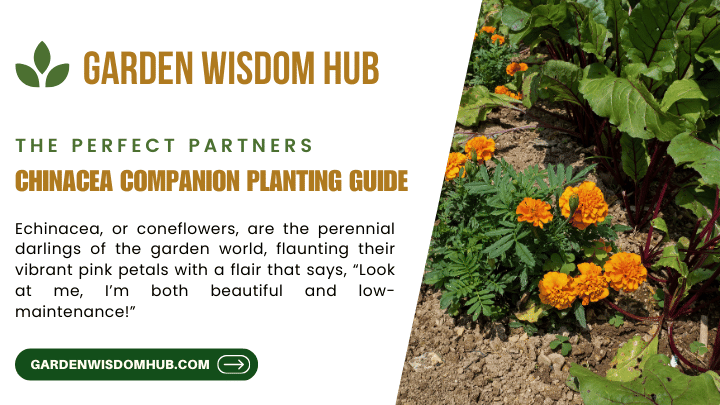Companion plants for coneflowers: Echinacea companion plants
Echinacea, or coneflowers, are the perennial darlings of the garden world, flaunting their vibrant pink petals with a flair that says, “Look at me, I’m both beautiful and low-maintenance!”
These resilient green companions are easy on the eyes and play well with their garden buddies, improving both their appearance and overall health. This guide will help you create a vivid, lively, and whimsical landscape by discovering the perfect Echinacea partners. This guide will explore:
- What to plant with Echinacea
- What not to plant with Echinacea
- What plants go well with Echinacea?
- Where is the best place to plant Echinacea?
- Echinacea companion plants vegetables
The Ingenious Logic Behind Echinacea Companion Planting
Echinacea, the garden overachiever, thrives with little effort! It grows well in sunny, well-draining soil, making it a useful garden plants.
Like casting a wacky ensemble cast for your garden, choosing plants with similar growing tendencies can boost its health and beauty to new heights. Echinacea plant companions are useful for many purposes.
Top 5 Best Companion Plants for Echinacea
Let us discuss the Best Plant companion plants for Echinacea. Here are some great companions to grow with echinacea to help your garden thrive and attract pollinators
1. Bee Balm (Monarda):
This beautiful plant attracts bees and many other pollinators, like a party crasher. With its colorful blooms and fragrant foliage, it’s nature’s invitation to pollinate.
Bee balm and echinacea are a dynamic couple in the garden, each contributing to its buzz and flair. Both plants thrive in full sun and well-drained soil, and their strikingly different flower forms make even the most austere botanist smile.
Bee balm’s tiny crown-shaped blooms attract bees and butterflies, turning your garden into a bustling haven for these beneficial insects.
2. Coral bells:
With foliage that ranges from lime green to deep burgundy, Coral Bells can take the focus from echinacea’s blooms, creating a Shakespearean botanical rivalry.
These charming small green friends are easy to care for in similar sunlight and provide a lush display even when the echinacea isn’t flowering.
Ah, it is the universal symbol of brevity and mystery! A single asterisk has many meanings. Is that a punctuation star or a footnote waiting to happen?
3. Lavender:
The adorable purple flower with it’s exceptional characteristics in relaxing and aromatherapy. Lavender and Echinacea make a lovely pair, suggesting, “Why stress when you can smell fabulous?”
Their relaxing scent and attractive lavender blossoms would charm even the most discerning garden gnomes.
Both plants love sun and thrive in well-drained areas, while lavender’s silvery-green color complements echinacea’s vivid one.
4. Black-Eyed Susan (Rudbeckia):
The party-animal flower with a cheerful demeanor and a dark center that demands attention. The garden’s vitality brings cheer and fun to any flower gathering.
These daisy-like blossoms are nature’s confetti, splashing yellow and gold throughout the yard and clashing with echinacea’s royal purple and pink costumes. These two hardy plants add late-summer beauty to your garden with little effort. Who knew gardening was so simple and colorful?
5. Red, Yellow, and Purple Echinacea Varieties
A Colorful Trio of Echinacea includes Red, Yellow, and Purple Blending. Echinacea tones creates a stunning, kaleidoscopic artwork that even the most sophisticated art critic would admire—if they could stop sneezing.
Why not experiment with red, yellow, and purple flowers for a vivid, textured garden that would make a painter cry?
The Delightfully Decorative World of Grasses and Foliage
Switchgrass and fountain grass make your landscape feel like a botanical ballet with their texture and movement. Low-growing sedges can create a lovely green carpet at the feet of echinacea, finishing a layered garden design—even plants like a nice foundation.
Essential Tips for Pairing Plants with Echinacea: Echinacea Companion Planting Guide (Coneflower)
Choose plants that dance with complementary or contrasting hues for a beautifully balanced display. To keep your garden vibrant, choose plants that bloom in rhythm or take turns.
Growth Habit:
Pairing tall and short plants creates a beautiful visual feast and stimulates robust growth, like a well-cast botanical play.
Echinacea plants, native to North America, are like the garden’s elegant guests—beautiful and environmentally friendly, proving that beauty and function can coexist.
Why grow Echinacea?
Let’s explore Echinacea’s charming world and discover why gardeners love it:
Cultivation Circumstances
Echinacea thrives in bright sunlight and soil that drains like a punchline, making it the plant world’s chameleon! Once established, these plants are like garden introverts, content with little care and occasional rain.
Sometimes a little deadheading can bring out new blooms, but don’t be too hasty—leaving a few faded flowers can be a delicious fall and winter smorgasbord for our feathered friends. Gardening as bird catering—who knew?
A Menagerie of Marvels
Echinacea, the plant world’s social butterfly, hosts a pollinator party bees and butterflies love. When it becomes cold, birds descend on its seed heads for a gourmet meal. It is like a seasonal buffet!
The Herbal Superstar
Echinacea has been a herbal superstar for years, known for its immune-boosting properties and ability to treat cold symptoms. Who knew flowers could fight cold?
Echinacea is the flower diva of garden design, taking centre stage in any design! A plethora of ideas for a cohesive, all-season exhibition.
Echinacea’s purple and pink hues and yellow black-eyed susans’ sunny disposition can create a visual feast, or you could choose a monochromatic scheme that sings in perfect harmony—who doesn’t love a color-coordinated garden party?
The Art of Elevation
Echinacea grows to 2–4 feet, making it the excellent mid or back layer plant in your garden beds. Height was so charming—who knew?
Like a well-staged play with everyone knowing their role, place the miniature flora in front and the towering titans in the rear to create a pleasant illusion of depth.
Echinacea, with its natural appeal for pollinators, is great for a themed garden, especially when combined with bee balm, lavender, and salvia. Like a garden party with VIP bees.
Consider pairing Echinacea with roses, phlox, and the eager Erigeron in a cottage garden’s pandemonium. A floral soiree offers beauty and whimsy!
Seasonal Shenanigans for Echinacea Extravaganzas: A Planting Parade
To keep the color wheel turning, pair Echinacea with spring bulbs and fall-blooming perennials. Winter is lovely, when the environment is frozen and nature slows down.
Trees become introverted, dropping their leaves and adopting a basic style. Do not worry! The seed heads of Echinacea make a beautiful winter sight and a gourmet feast for birds.
Who knew gardening could be fun and useful? Add some evergreen plants or grasses to make your garden shine year-round! Who says plants can’t celebrate year-round?
What botanical companions does Echinacea avoid?
A glitch appears to have occurred! I’d love to help you turn some text into something fun and clever. Share your ideas.
Avoid ferns and hosts, which are introverts that thrive in shade. Avoid overambitious plants like bamboo that seem to hate your garden.
How many coneflowers should I plant together?
Do you want to explore the appropriate amount of coneflowers for a lovely floral congregation? Plant 3 to 5 Echinacea close together, giving them 18 to 24 inches of space, for a stunning show. Flowers like elbow room, too!
What lovely companions should complement purple coneflowers?
Choose small plants like Coral Bells, sedums, or catmint to add color and preserve your view. Gardening as peek-a-boo? Who knew?
Can I plant Echinacea with vegetables?
Echinacea can attract pollinators to food gardens, making it a welcome guest. The wonderful trio of tomatoes, cucumbers, and beans—nature’s reminder that company is vital even in vegetables! Salads can be social.
Watch this Video For More Guide: Purple Coneflower – Echinacea purpurea
Frequently Asked Questions: Echinacea Companion Planting Guide (Coneflower)
Discover a beautifully detailed Q&A section on Echinacea, where botanical wisdom meets curiosity!
How many coneflowers should I plant together?
For a brilliant and prolific display, grow 3–5 Echinacea plants close together with 18–24 inches between them to avoid floral squabbles.
This lovely arrangement provides each plant the space it desires, preventing botanical brawls and creating a stunning, densely-packed ensemble that attracts pollinators and brightens your landscape.
What not to plant with Echinacea?
Avoid mixing Echinacea with plants with very different needs, such as shade-loving plants (e.g., ferns, hostas). Echinacea loves the sun, so these plants will feel like they’ve been invited to a beach party without sunscreen!
Hydration-Obsessed Flora (e.g., astilbe)
Echinacea is like that friend who needs little watering once it’s established in. Avoid high-maintenance plants with tantrum-prone roots.
Overzealous Proliferators (e.g., mint, bamboo):
They can invade garden beds and compete for resources and space, stifling Echinacea’s growth.
What to plant with Echinacea?
Asterisks are very mysterious! It moves between footnotes and multiplication like a ballet dancer. One can consider its existential relevance in punctuation’s great tapestry.
Shorter plants with dramatic foliage or flowers make great front-row companions for the regal purple coneflowers:
Coral Bells (Heuchera)
A delightful splash of color that stays low to avoid hiding from the Echinacea. The succulent stars of the plant world, sedums, thrive on neglect and prove that even botanicals may thrive with little care.
Nobody knew low-maintenance could be so chic. Consider a ground cover that’s as low-maintenance as a cat on a sunny windowsill but steals the attention from Echinacea. That botanical task is worth tackling.
Catmint (Nepeta)
This lavender-blue plant balances purple echinacea in this botanical drama. These charming plants are like supporting performers in a garden drama, giving depth without overshadowing echinacea.
What are Coneflower companion plants vegetables?
Echinacea are like a delightful dinner guest which adds color and health advantages to your veggie garden.
Its siren-like song attracts pollinators, increasing vegetable production and coexisting with many veggie companions.
The joys of vegetable company! Your garden needs these superstars:
Tomatoes:
They are sometimes misunderstood for vegetables yet proudly waving their fruit flag.
Cucumbers:
Cool, crisp salad companions noted for their pickling ability.
Beans:
These protein-packed legumes may add flavour to any recipe.
These plants love sun and water, and Echinacea attracts pollinators, which can turn your vegetable garden into a productive Eden.
Conclusion: Echinacea Companion Planting Guide (Coneflower)
These above mentioned principles are your guide to growing a garden that exhibits Echinacea and welcomes our lovely wildlife friends.
Who knew gardening could be a wildlife party and visual feast? Feel free to shout for advice or direction! These additional amusing guides will help you create a beautiful, eco-friendly garden that showcases the plant:
- When to Harvest Sunflower Seeds
- Best Time to Plant Sunflowers
- Top 10 Flowering Vines for Shade
- How To Prune Hellebores In Summer
- Companion Planting Yarrow
James Porter
Welcome to our haven of gardening and plant care, where outdoor and indoor planting enthusiasts come together! At Gardening Wisdom Hub, we aim to provide you with the most authentic information on anything related to gardening, plant care, seasonal planting etc.
The author of our website is James Porter, an experienced industry veteran. He has a deep interest in everything green. James’s enthusiasm for exploring plants’ features and learning new gardening methods began at a young age. Gradually, his passion increased with time, leading him to become a highly esteemed professional. His extensive knowledge makes him a priceless resource for inexperienced and seasoned gardeners.

